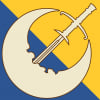1925 Phantom of the Opera Mask
 Alexander H
✭✭✭
Alexander H
✭✭✭
I’ve been a huge fan of Andrew Lloyd Webber’s rendition of Phantom of the Opera since a young lad. Late last year, I finally found the chance to watch the 1925 film version of the novel, starring Lon Chaney Sr. as the Phantom.
While the film was extremely well crafted, especially for the time, what really amazed me was reading about Lon Chaney behind the scenes - how he largely built his career not only on his acting, but on his prosthetic and special effects skills.
So for Halloween 2024, I decided to make the 1925 Phantom of the Opera mask!
It started with an old head scan I’ve been using to create masquerade masks for years now. Using the same process used in retopology, I meshed the shape around the head. Finding references for the mask was very difficult, as many of the photos online are of low quality, or only show it from a few specific angles. This article by user Weaselrama takes a more analytical look at the mask, and my task was also made easier by finding a high quality copy of the film online (since, eerily enough, the DVD doesn’t seem to want to play in my computer).
Because of the age and low quality of the photogrammetry scanned head model, it took about three iterations to get the mask to a shape that was not only as screen accurate as possible, but also comfortable. Thus, proportionately, it does differ a slight amount from the film (mainly to compensate for my big nose).
The mask was printed in two parts (so a flat surface could contact the print bed), with recessed diamonds on the back to help with alignment. The back of the mask is reinforced with a fibreglass weave, adhered with five minute epoxy - not the most practical solution for working with fibreglass, but a cheaper and less messy one. Sharp points were carefully ground down, and the back was very thoroughly cleaned to remove any lingering particles.
After sanding thoroughly to produce a smooth surface, the mask was given a light tan base, then a clear coat. The shading around the eyes was done with brown and black oil paints, in multiple very light layers, using a soft brush to eliminate strokes and to easily fade out. Prior masking around the bottom of the eyebrows was done to create a sharp edge. A makeup remover pad (leftover from my Jack Skellington days) proved to be remarkable for cleaning up oil paints that went in the wrong areas, leaving a crisp edge. The mask was then again clear coated, and the eyebrows were then painted black. In the model, there is a small recess where the eyebrows are to make painting easier, without having to either guess or mask where they are, making symmetry easier. However, I made this recess too shallow in the final print, so I had to be very cautious during the sanding stage not to sand down or fill in around the edges of the eyebrows (this was adjusted for the final model).
Once a final clear coat was given, some 1mm EVA foam was glued onto the back for comfort. Ideally, if used in longer situations, some thin silicone would work best as to not absorb sweat or facial oils (making clean up easier). Strapping was then added around the sides and top of the mask to hold it in place, which is largely hidden by the skull cap.
The veil below the mouth is white chiffon, chosen for its transparency and delicate look. It was hand patterened, cut and sewn, then inverted and glued to the mask.
Since I could not find anything online to match the simplicity and style of the skull cap used in the film, I ended up making one myself from black velvet. The pattern was made in Blender and then sewn together in five identical pieces.

If anyone is interested, I have the 3D model of the mask (and skull cap pattern) available for free from my website!
